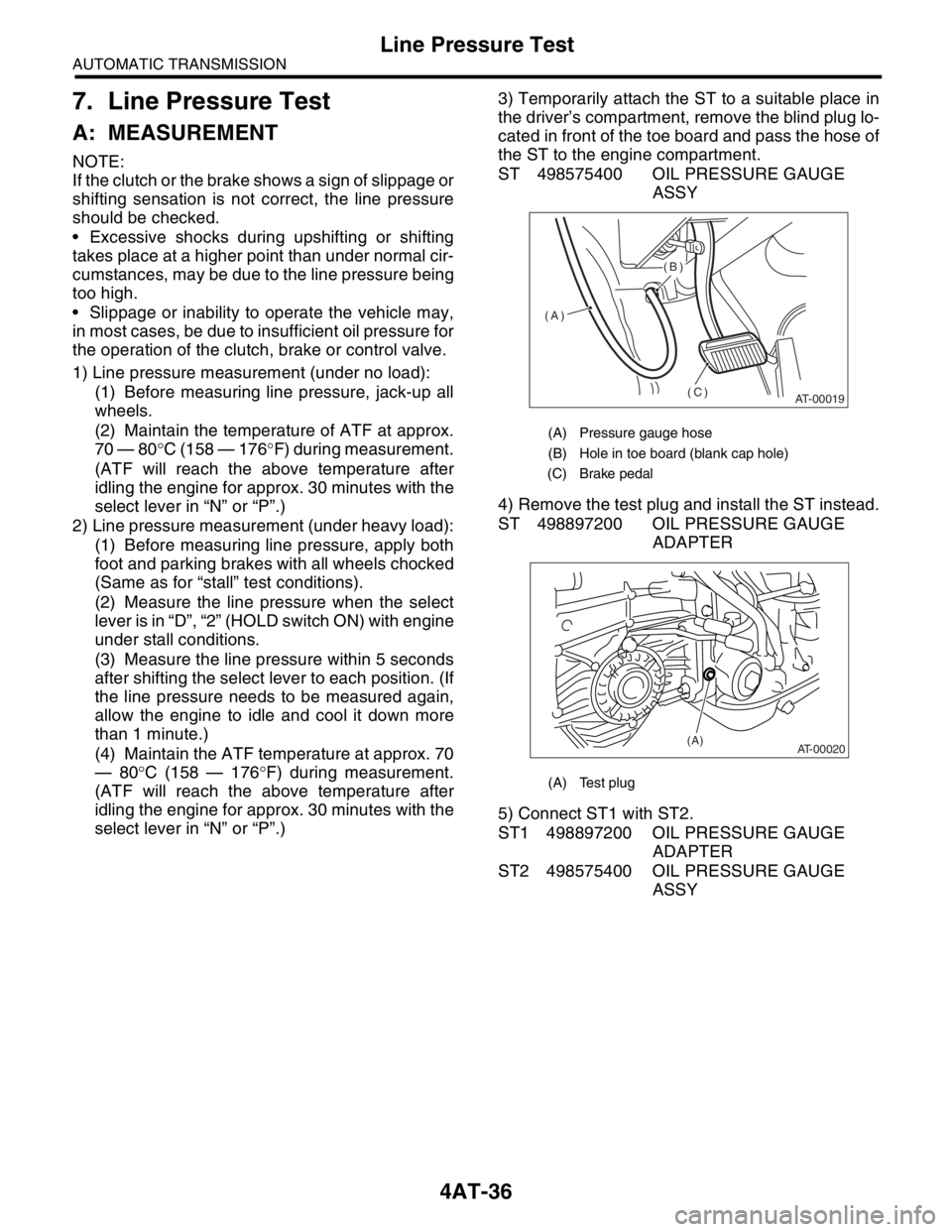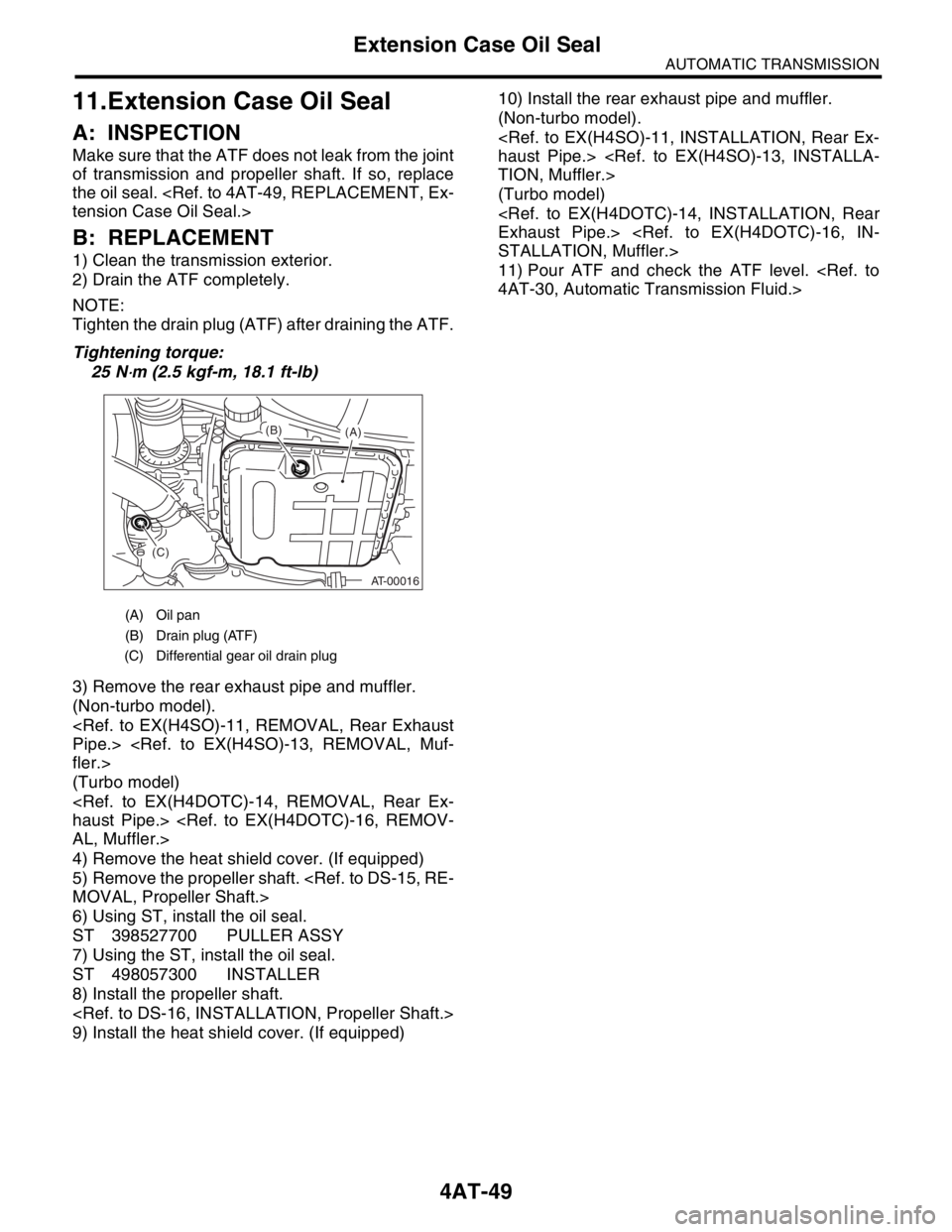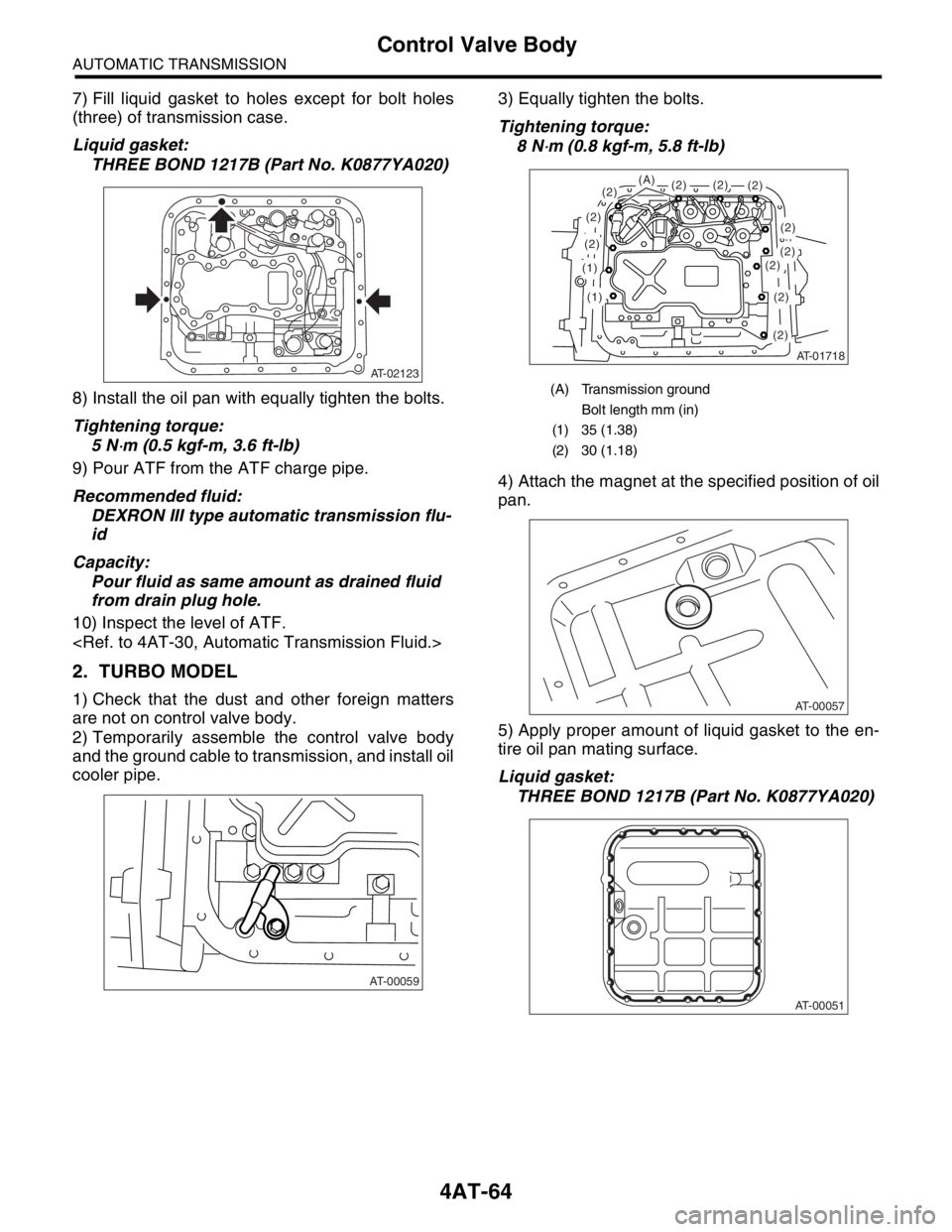2004 SUBARU FORESTER check oil
[x] Cancel search: check oilPage 2344 of 2870

4AT-32
AUTOMATIC TRANSMISSION
Road Test
4. Road Test
A: INSPECTION
1. GENERAL PRECAUTION
Road tests should be conducted to properly diag-
nose the condition of the automatic transmission.
NOTE:
When performing the test, do not exceed posted
speed limit.
2. D RANGE SHIFT FUNCTION
Check shifting between 1st ←→ 2nd ←→ 3rd ←→
4th while driving on normal city streets.
3. D RANGE SHIFT SHOCK
Check the shock level when shifting up during nor-
mal driving.
4. KICK-DOWN FUNCTION
Check kick-down for each gear. Also check the
kick-down shock level.
5. ENGINE BRAKE OPERATION
Check the 3rd gear engine brake when shifting
down from D ←→ 3rd range while driving in 4th
gear of D range [50 — 60 km/h (31 — 37 MPH)].
Check the 2nd gear engine brake when shifting
between 3rd ←→ 2nd range while driving in the 3rd
range of 3rd gear [40 — 50 km/h (25 — 31 MPH)].
Check the 1st gear engine brake when shifting
between 2nd ←→ 1st range while driving in the 2nd
range of 2nd gear [20 — 30 km/h (12 — 19 MPH)].
6. LOCK-UP FUNCTION
Check that rpm does not change sharply when
the axle pedal is lightly depressed when driving on
flat roads at 60 km/h (37 MPH).
Check slip lock-up with following procedure.
Subaru Select Monitor is needed for checking (EC,
EK model).
Before start checking, check that the DTC is not ex-
isted using Subaru Select Monitor. When the DTC
is existed, perform the collective action with DTC
and check that the DTC is not existed again, and
then start the checking.
1) The check performed on flat and straight road or
free roller.
NOTE:
Slip lock-up does not operate when the vehicle is
lifted up, because of not occurring surface resis-
tance.
Also checking on the free roller, check with de-
pressing foot brake lightly to make the checking
easier, because the surface resistance will be defi-
cient2) Connect the Subaru Select Monitor.
3) Check ATF temperature using Subaru Select
Monitor.
NOTE:
ATF temperature is between 50 — 100°C (122
— 212°F).
When the temperature is low, warm-up the ATF
by running the vehicle or etc.
4) Start the engine, and make the lock-up duty be
able to read on data display of Subaru Select Mon-
itor.
5) 35 — 40 Drive the vehicle at a constant speed of
35 — 40 km/h (22 — 25 MPH).
6) Read the lock-up duty while vehicle is running.
Standard value:
25 — 45%
NOTE:
On the free roller, the value sometimes lowers.
Slip lock-up control is not operating when the
lock-up duty is less than 5%, or when the lock-up
duty goes down immediately after starts rise. On
these cases, improper ATF or deterioration of ATF
may be the cause. Check the amount of ATF or re-
place them, and then recheck it.
7. P RANGE OPERATION
Stop the vehicle on an uphill grade of 5% or more
and shift to “P” range. Check that the vehicle does
not move when the parking brake is released.
8. NOISE AND VIBRATION
Check for unusual sounds and vibration while driv-
ing and during shifting.
9. CLIMBING CONTROL FUNCTION
Check that the gear remains in 3rd when going
up a grade.
Check that the gear remains in 3rd when apply-
ing the brakes while going down a grade.
10.TRANSFER CLUTCH
Check tight corner braking when the vehicle started
with steering fully turned.
11.OIL LEAKS
After the driving test, inspect for oil leaks.
Page 2345 of 2870

4AT-33
AUTOMATIC TRANSMISSION
Stall Test
5. Stall Test
A: INSPECTION
NOTE:
The stall test is of extreme importance in diagnos-
ing the condition of the automatic transmission and
the engine. It should be conducted to measure the
engine stall speeds in “R” and “2” ranges (when
HOLD switch is ON).
Purposes of the stall test:
To check the operation of the automatic trans-
mission clutch.
To check the operation of the torque converter
clutch.
To check engine performance.
1) Check that the throttle valve opens fully.
2) Check that the engine oil level is correct.
3) Check that the coolant level is correct.
4) Check that the ATF level is correct.
5) Check that the differential gear oil level is cor-
rect.
6) Increase ATF temperature to 70 — 80°C (158 —
176°F) by idling the engine for approximately 30
minutes (with select lever set to “N” or “P”).
7) Place the wheel chocks at the front and rear of
all wheels and engage the parking brake.
8) Shift the manual linkage to ensure it operates
properly, then shift the select lever to the “2” range
and turn the HOLD switch to ON.
9) While forcibly depressing the foot brake pedal,
gradually depress the accelerator pedal until the
engine operates at full throttle.
10) When the engine speed is stabilized, record
that speed quickly and release the accelerator ped-
al.
11) Shift the select lever to “N” range, and cool
down the engine by idling it for more than one
minute.12) If the stall speed in “2” range (with HOLD switch
ON) is higher than specifications, low clutch slip-
ping and “2-4 brake slipping” may occur. To identify
it, conduct the same test as above in “R” range.
13) Perform the stall tests with the select lever in
the “D” range.
NOTE:
Do not continue the stall test for more than five
seconds at a time (from closed throttle, fully open
throttle to stall speed reading). Failure to follow this
instruction causes the engine oil and ATF to deteri-
orate and the clutch and brake to be adversely af-
fected.
Be sure to cool down the engine for at least one
minute after each stall test with the select lever set
in the “P” or “N” range and with the idle speed lower
than 1,200 rpm.
If the stall speed is higher than the specified
range, attempt to finish the stall test in as short a
time as possible, in order to prevent the automatic
transmission from sustaining damage.
Stall speed (at sea level):
2.0 L NON-TURBO MODEL
2,000 — 2,500 rpm
2.0 L TURBO MODEL
2,600 — 3,300 rpm
2.5 L NON-TURBO MODEL
2,100 — 2,600 rpm
2.5 L TURBO MODEL
2,700 — 3,200 rpm
(A) Brake pedal
(B) Accelerator pedal
(A) (B)
P
R
N
D
3
2
1
AT-00449
Page 2348 of 2870

4AT-36
AUTOMATIC TRANSMISSION
Line Pressure Test
7. Line Pressure Test
A: MEASUREMENT
NOTE:
If the clutch or the brake shows a sign of slippage or
shifting sensation is not correct, the line pressure
should be checked.
Excessive shocks during upshifting or shifting
takes place at a higher point than under normal cir-
cumstances, may be due to the line pressure being
too high.
Slippage or inability to operate the vehicle may,
in most cases, be due to insufficient oil pressure for
the operation of the clutch, brake or control valve.
1) Line pressure measurement (under no load):
(1) Before measuring line pressure, jack-up all
wheels.
(2) Maintain the temperature of ATF at approx.
70 — 80°C (158 — 176°F) during measurement.
(ATF will reach the above temperature after
idling the engine for approx. 30 minutes with the
select lever in “N” or “P”.)
2) Line pressure measurement (under heavy load):
(1) Before measuring line pressure, apply both
foot and parking brakes with all wheels chocked
(Same as for “stall” test conditions).
(2) Measure the line pressure when the select
lever is in “D”, “2” (HOLD switch ON) with engine
under stall conditions.
(3) Measure the line pressure within 5 seconds
after shifting the select lever to each position. (If
the line pressure needs to be measured again,
allow the engine to idle and cool it down more
than 1 minute.)
(4) Maintain the ATF temperature at approx. 70
— 80°C (158 — 176°F) during measurement.
(ATF will reach the above temperature after
idling the engine for approx. 30 minutes with the
select lever in “N” or “P”.)3) Temporarily attach the ST to a suitable place in
the driver’s compartment, remove the blind plug lo-
cated in front of the toe board and pass the hose of
the ST to the engine compartment.
ST 498575400 OIL PRESSURE GAUGE
ASSY
4) Remove the test plug and install the ST instead.
ST 498897200 OIL PRESSURE GAUGE
ADAPTER
5) Connect ST1 with ST2.
ST1 498897200 OIL PRESSURE GAUGE
ADAPTER
ST2 498575400 OIL PRESSURE GAUGE
ASSY
(A) Pressure gauge hose
(B) Hole in toe board (blank cap hole)
(C) Brake pedal
(A) Test plug
AT-00019
(A)(B)
(C)
AT-00020(A)
Page 2350 of 2870

4AT-38
AUTOMATIC TRANSMISSION
Transfer Clutch Pressure Test
8. Transfer Clutch Pressure
Test
A: INSPECTION
Check the transfer clutch pressure in accordance
with the following steps in the same manner as with
line pressure.
ST 498897700 OIL PRESSURE ADAPTER
SET
ST 498575400 OIL PRESSURE GAUGE
ASSYNOTE:
Before setting in FWD mode, install the spare fuse
on FWD mode switch.
NOTE:
If the oil pressure is not produced or if it does not
change in the AWD mode, the transfer duty sole-
noid or transfer valve assembly may be malfunc-
tioning. If the oil pressure is produced in the FWD
mode, the problem is similar to that in the AWD
mode.
STANDARD TRANSFER CLUTCH PRESSURE:
NON-TURBO MODEL
TURBO MODEL
(A) Test plug
AT-00021
(A)
Range posi-
tionON Duty
ratio (%)Acceleration opening angle (%)AWD m od e
Transfer clutch pressure
(kPa (kg/cm
2, psi))FWD mode
Transfer clutch pressure
(kPa (kg/cm2, psi))
D95100
(Fully opens)910 — 1,070
(9.3 — 10.9, 132 — 155)—
D60Adjust ON Duty ratio to 60%.
(Target 10%)410 — 490
(4.2 — 5.0, 59 — 71)—
N or P 50
(Fully closed)0—
D50
(Fully closed)—0
Range posi-
tionON Duty
ratio (%)Acceleration opening angle (%)AWD m od e
Transfer clutch pressure
(kPa (kg/cm
2, psi))FWD mode
Transfer clutch pressure
(kPa (kg/cm2, psi))
295100
(Fully opens)930 — 1,100
(9.5 — 11.2, 135 — 160)—
260Adjust ON Duty ratio to 60%.
(Target 12%)420 — 560
(4.3 — 5.7, 61 — 81)—
N or P 50
(Fully closed)0—
250
(Fully closed)—0
Page 2358 of 2870

4AT-46
AUTOMATIC TRANSMISSION
Automatic Transmission Assembly
33) Connect the ATF cooler hoses to pipes on
transmission side, and then install the oil charge
pipe. (with ATF cooler (with warmer function))
34) Install the ATF level gauge guide.
35) Connect the following connectors.
(1) Transmission harness connectors
(2) Transmission ground terminal
36) Install the harness to bracket.
37) Install the air cleaner case stay. (Non-turbo
model)
Tightening torque:
16 N
⋅m (1.6 kgf-m, 11.6 ft-lb)38) Install the air cleaner case and air intake duct.
(Non-turbo model).
39) Install the intercooler. (Turbo model)
40) Connect the battery ground cable to battery.
41) Pour ATF from the oil charge pipe.
42) Check the ATF level.
43) Take off the vehicle from a lift.
44) Check the select lever operation.
45) Execute the learning control promotion. (Turbo
model)
Select Monitor.>
46) Perform the road test.
(A) Inlet hose
(B) Outlet hose
AT-01866(A)(B)
AT-00693
AT-01867
Page 2362 of 2870

4AT-49
AUTOMATIC TRANSMISSION
Extension Case Oil Seal
11.Extension Case Oil Seal
A: INSPECTION
Make sure that the ATF does not leak from the joint
of transmission and propeller shaft. If so, replace
the oil seal.
B: REPLACEMENT
1) Clean the transmission exterior.
2) Drain the ATF completely.
NOTE:
Tighten the drain plug (ATF) after draining the ATF.
Tightening torque:
25 N
⋅m (2.5 kgf-m, 18.1 ft-lb)
3) Remove the rear exhaust pipe and muffler.
(Non-turbo model).
(Turbo model)
4) Remove the heat shield cover. (If equipped)
5) Remove the propeller shaft.
6) Using ST, install the oil seal.
ST 398527700 PULLER ASSY
7) Using the ST, install the oil seal.
ST 498057300 INSTALLER
8) Install the propeller shaft.
9) Install the heat shield cover. (If equipped)10) Install the rear exhaust pipe and muffler.
(Non-turbo model).
(Turbo model)
11) Pour ATF and check the ATF level.
(A) Oil pan
(B) Drain plug (ATF)
(C) Differential gear oil drain plug
AT-00016
(A) (B)
(C)
Page 2363 of 2870

4AT-50
AUTOMATIC TRANSMISSION
Differential Side Retainer Oil Seal
12.Differential Side Retainer Oil
Seal
A: INSPECTION
Check the leakage of gear oil from differential side
retainer oil seal part.
If there is oil leakage, replace the oil seal.
B: REPLACEMENT
1) Lift-up the vehicle.
2) Remove the front exhaust pipe and center ex-
haust pipe.
(Non-turbo model)
(Turbo model)
3) Drain the differential gear by removing differen-
tial gear oil drain plug.
4) Replace new gasket and tighten the differential
oil drain plug.
Tightening torque:
44 N
⋅m (4.5 kgf-m, 32.5 ft-lb)
5) Separate the front drive shaft from transmission.
6) Remove the differential side retainer oil seal us-
ing driver which wrapped with vinyl tape or etc.7) Using ST, install the differential side retainer oil
seal by slightly tapping with hammer.
ST 18675AA000 DIFFERENTIAL SIDE OIL
SEAL INSTALLER
8) Apply oil to the oil seal lips.
9) Using the ST, install the front drive shaft.
ST 28399SA010 OIL SEAL PROTECTOR
10) Install the front exhaust pipe and center ex-
haust pipe.
(Non-turbo model)
(Turbo model)
11) Lower the vehicle.
12) Pour differential gear oil into the gauge hole.
Recommended gear oil:
GL-5 (SAE: 75 W-90) or equivalent
Differential gear oil capacity:
1.1 — 1.32 (1.3 — 1.4 US qt, 1.0 — 1.1 Imp qt)
13) Check the gear oil amount.
(A) Oil pan
(B) Drain plug (ATF)
(C) Differential gear oil drain plug
AT-00016
(A) (B)
(C)
AT-00029
ST
Page 2377 of 2870

4AT-64
AUTOMATIC TRANSMISSION
Control Valve Body
7) Fill liquid gasket to holes except for bolt holes
(three) of transmission case.
Liquid gasket:
THREE BOND 1217B (Part No. K0877YA020)
8) Install the oil pan with equally tighten the bolts.
Tightening torque:
5 N
⋅m (0.5 kgf-m, 3.6 ft-lb)
9) Pour ATF from the ATF charge pipe.
Recommended fluid:
DEXRON III type automatic transmission flu-
id
Capacity:
Pour fluid as same amount as drained fluid
from drain plug hole.
10) Inspect the level of ATF.
2. TURBO MODEL
1) Check that the dust and other foreign matters
are not on control valve body.
2) Temporarily assemble the control valve body
and the ground cable to transmission, and install oil
cooler pipe.3) Equally tighten the bolts.
Tightening torque:
8 N
⋅m (0.8 kgf-m, 5.8 ft-lb)
4) Attach the magnet at the specified position of oil
pan.
5) Apply proper amount of liquid gasket to the en-
tire oil pan mating surface.
Liquid gasket:
THREE BOND 1217B (Part No. K0877YA020)
AT-02123
AT-00059
(A) Transmission ground
Bolt length mm (in)
(1) 35 (1.38)
(2) 30 (1.18)
AT-01718
(1)
(1)
(2)
(2)
(2)(2)
(2)
(2)(2)(2)(2)
(2)
(2)
(A)
AT-00057
AT-00051